Lecture 9:Thermoregulation lll
1/31
There's no tags or description
Looks like no tags are added yet.
Name | Mastery | Learn | Test | Matching | Spaced |
|---|
No study sessions yet.
32 Terms
The surrounding fluid whether water or air, makes impact on how rapid you will loose heat to environment
Air has low specific heat capacity, as heat leaves body, it will warm air up. As air warms up, the thermal gradient will decrease and slow down rate of any further heat lose
Water has high specific heat capacity. As heat is leaving body of aquatic animal it doesn’t warm up water. So thermal gradient remains high, and aquatic animal loose heat much more readily to environment because water is not heating as rapidly
Convection
Type of conduction facilitated by fluid flow and/or body movement
Heat leaving persons arm into air, so air will get warmed up. As air around body gets heated up that will slow down rate of any heat loss.
A windy day, will take the hot air (changed because of the heat coming off the persons body) blow it away from persons body, and bring cool air to replace it
As heated air is pushed away, thermal gradient between arm and air maintained. Fast rate of conducted heat loss also maintained
Also why you feel cooler when you stand in front of fan (cooler air, replaces warm air)
Convection also happens when animals are moving within a stationary environment
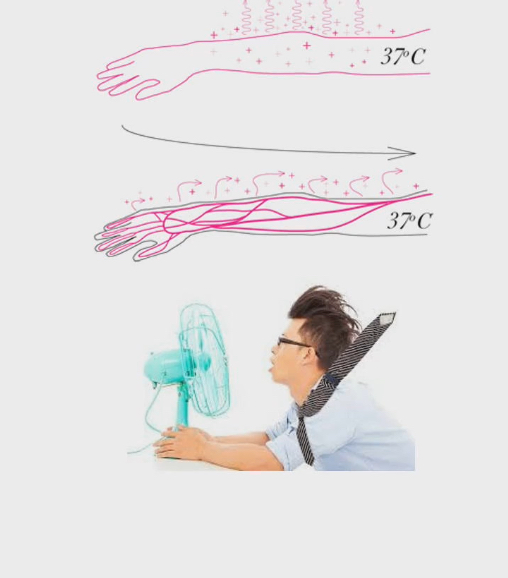
Convection has 2 types of flow
Laminar flow
Turbulent flow
Laminar flow
Air is flowing in smooth pathways forward
Less effective convective heat exchange because a single current of air, that will minimize its contact with possible surfaces in environment

Turbulent flow
More chaotic
Air is swirling back and forth
More effective at convective heat exchange because a the swirling motions = spend more time in contact with body surface and more opportunity for convective exchange
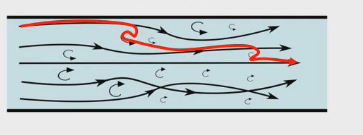
Dinosaur reptiles demonstrating laminar vs turbulent flow
Had bumpy sails on their backs
Purpose: caused any air flowing past them to demonstrate turbulent flow = higher rate of convention to cool the reptile

Electromagnetic radiation Have 2 types
they cause molecules to move to greater degree/ Move more and generate more heat
Infrared
Microwave
Indirectly relevant types of radiation
Ultraviolet and visible radiation
They don’t directly change motion of molecules, they cause excitation of electrons to higher energy orbitals → when electrons fall back to ground state, it doesn’t happen all at once, rather orbital by orbital, so they give off lower energy types of radiation and get converted to infrared radiation
Radiative heat does not require
Direct contact between objects
Travelling occurs in photons (packets of energy)
We can get heat from sun without touching it
Weins’s Displacement Law
every object with temp above absolute 0 will radiate energy
What differs is the amount and type of radiation that is given off
Since in the grand scheme of universe animals body temp is pretty low, we don’t emit that much radiation
Yellow line is the sun. Because sun is much hotter than us (red line) not only does it emit way more radiation than us, it also emits lots of other types of radiation (infrared, visible and ultraviolet radiation given off)
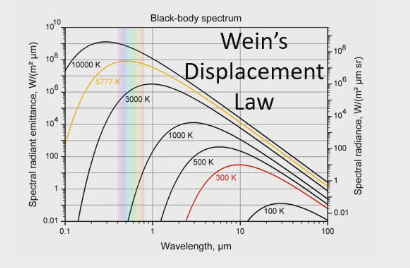
Stefan-Boltzmann Equation
q= rate that our bodies gain or loose heat via radiation
A= area. More surface area of body exposed to sun, the faster rate of body will heat up.
Temperature difference= heat goes from hotter to colder
If the sun is out, it is hotter than you, so you will gain heat in body
If sun is behind clouds and it’s cold outside you will loose heat from body
ε = emissivity/ absorptivity
Different objects emit and absorb radiation different
We don’t care about sigma
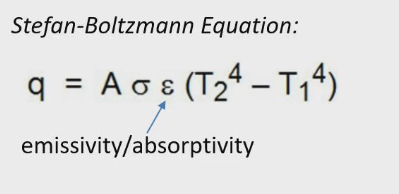
Radiation : colour
Excited electron will go back to ground state orbit by orbit and will emit lower energy types of radiation like infrared radiation → contribute to warming of body
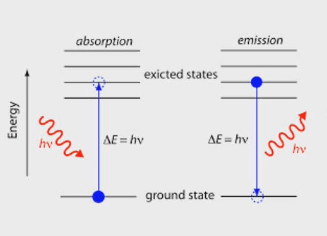
3 types of springbok
Normal (orange colour) is dominant in population
Black and white springbok don’t have as efficient thermoregulation and are less fit
In winter:
White springboks have hard time keeping body temp up, and it is significantly lower than its temp in spring, summer and fall
This is because colour white reflects colour off surface. White springbok is reflecting all the light → it can’t get any heat production → no electron excitation → no infrared radiation
In spring
Black springbok have a higher max body temp, because black absorbs every colour of visible light → all colour are being absorbed → electron excitation → infrared production → heat
Black springboks do not have a higher max body temperature in summer because they can find shelter under trees. In spring lots of leaves aren’t out yet
Black and white springboks are not common because black springboks get too hot in spring, white springboks can’t generate enough heat in winter
Only normal springbok has normal body temp in all seasons
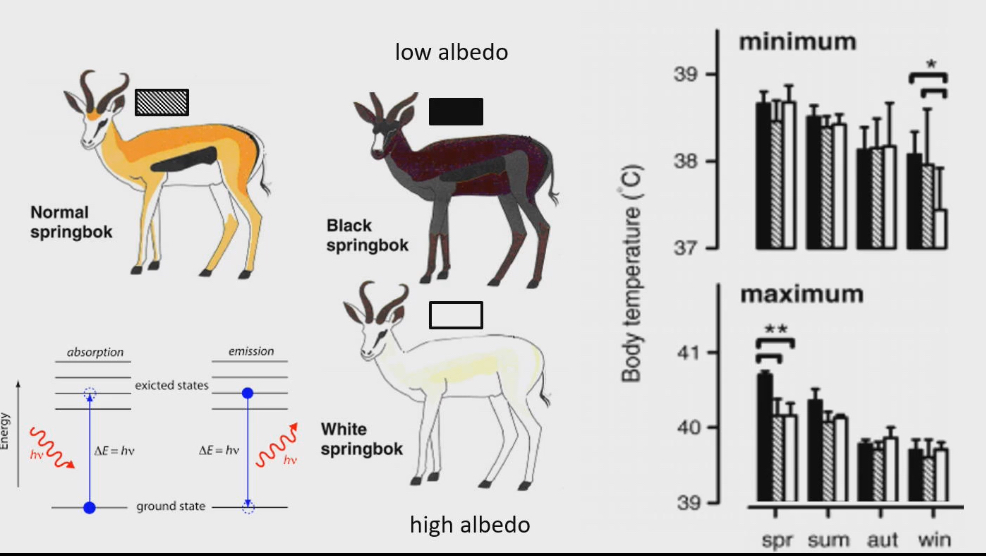
Radiation: orientation
Animals body oriented to radiation impacts the degree that radiative heat transfer occurs
Solar radiation comes at 90º to body → concentrates radiation → more effective heat transfer to occur
Solar radiation comes at 45º to body→ less intense heat transfer
Solar radiation comes at 0º to body or parallel→ no interaction at all, photons of radiation pass by
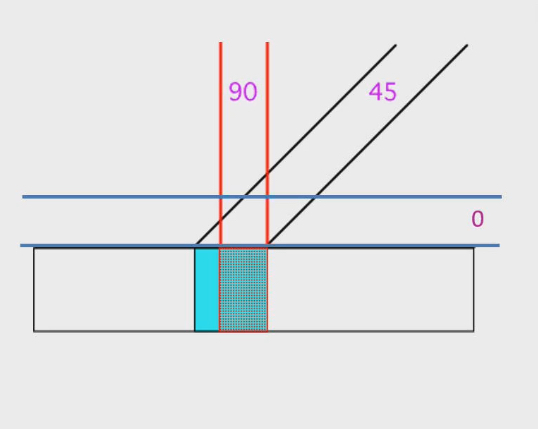
Evidence for Radiation: orientation
In winter:
All 3 animals want to be perpendicular to sun to maximize solar radiation heat gain
In summer:
All 3 animals want to be parallel to the sun to minimize heat gain
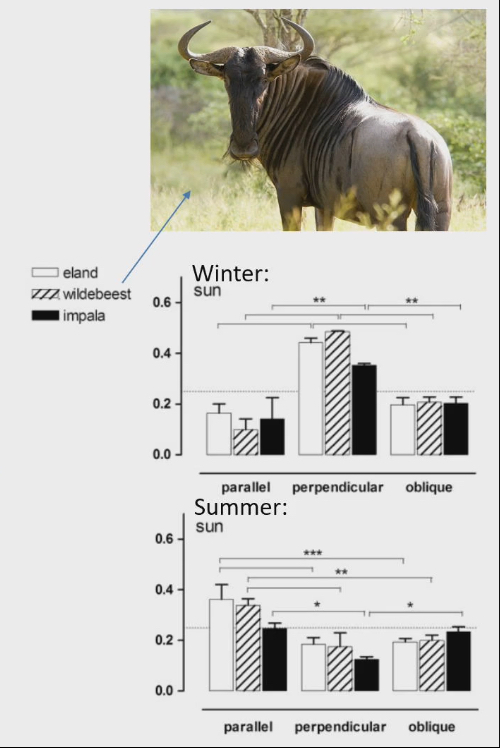
Conduction and radiation: postural changes
Dark eye junco adapts different postures
Level 1: leg and foot visible, stands as tall as it can
Posture 1→ 6 the bird crouches and crouches until at 6 you can’t see the legs therefore minimizing surface area exposure to surrounding environment
Expose junko to different temperatures to see what posture it would take on.
As the temp got colder they would adopt higher level posture → keep hiding legs and feet to minimize exposure and heat loss to cold air
Part 2 of study
Startle the bird and see how long it took for bird to get off the ground depending on the posture they were adopting at that time
Posture 1-3 (standing more upright and exposing more feet) → fly off faster than in more crouched posture 4-6
More crouched position, more risk of predation because it took them slower to fly away
Trade off exists between need for thermal regulation and risk of predation
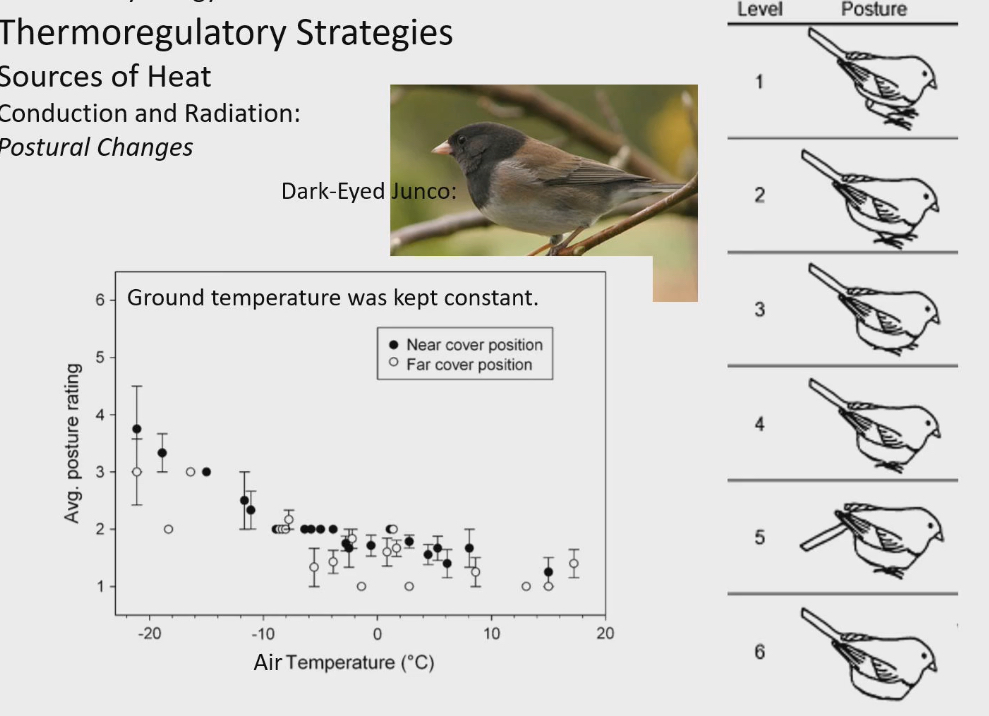
Conduction and radiation: vasomotor responses
Regulate blood flow to body surface that will maximize or minimize conductive and radiation heat gain/loss
2 parts to skin of vertabrate
Thin outer layer → epidermis (avascular so not blood vessels)
Thicker connective tissue → dermis (vascular so there are blood vessels)
We see this when animals are hot vasomotor responses
Shunt vessel is constricted meaning blood from arterial is forced in capillary bed of skin. So any heat contained in arterial blood comes into skin, very close to body surface and will facilitate radiative and conductive heat loss

We see this when animals are cold vasomotor responses
Shunt vessels are dilated
Blood goes from arterial → shunt vessel → venue
We are not using capillaries in skin at all
Not a lot of blood in capillary beds of skin, not much heat close to surface of body → minimize radiative and conductive heat loss
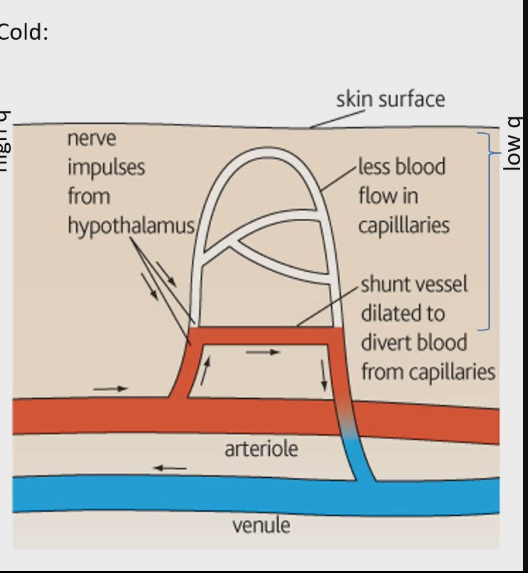
Vasomotor responses in Toco Toucan
Bird that has a bill that is the same size of body (bird is 50% beak) WHY?
Maybe sexual selection to appear more attractive mates
No evidence supports this hypothesis
Big beaks perfused with blood when they get too hot, big surface area of beaks radiates heat into environment
Evidence supports this hypothesis
More infrared radiation in beak (and none in body) when toucan is hot
Most of beak does not give off infrared radiation because they want to limit heat loss to environment when toucan is cold
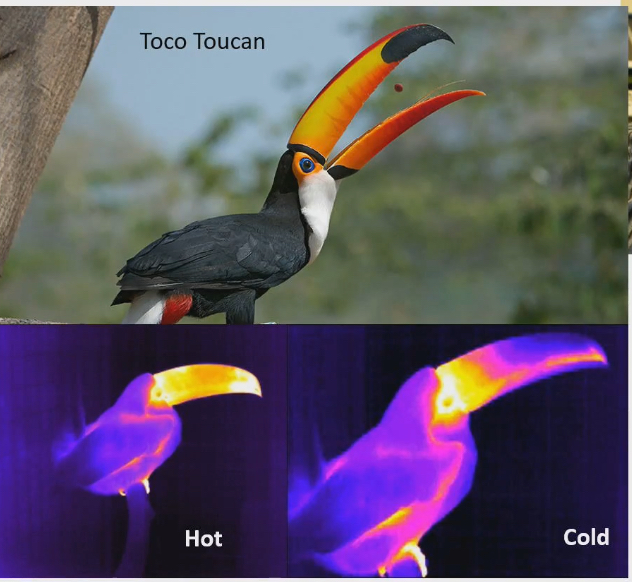
All birds to some degree use beaks to regulate body temperature
For lots of Bird families we measured size of birds beak (residual so accounting for body size) and compared it to latitude, altitude, Tmin
Latitude
At 0º at equator where its the hottest
As you move further from equator, beak size decreases
Birds living near equator use big beaks to expel heat into surroundings
Altitude
Sea level to cold higher altitudes, birds beaks get smaller
Tmin
As the environment get warmer, birds beaks gets longer and longer
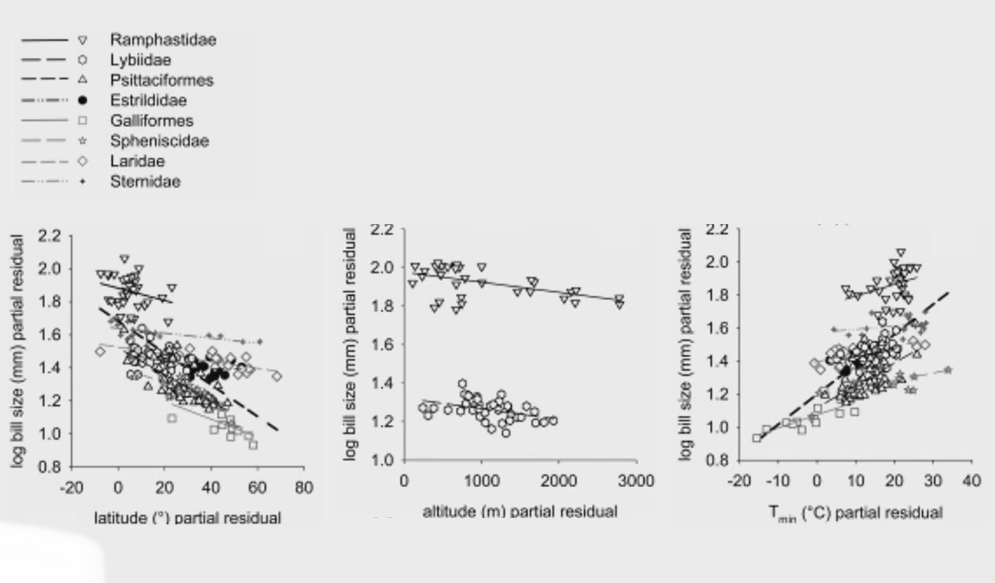
Allen’s Rule
mammals and birds living in colder climates have shorter extremities to better retain heat and minimize heat loss
Example of Allen’s rule in arctic and desert fox
Arctic fox have shorter ears to minimize heat loss through ears
Desert fox have much longer ears to radiate more heat to get more cool
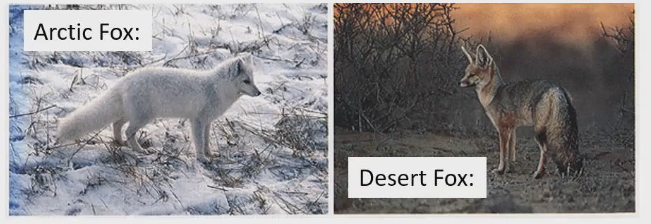
Bergman’s rule
Mammals and birds living in colder climates are larger
Spectacled bear lives near equator and smallest bear
Example
Black bears live in Ontario and medium size
Polar bears live in arctic and are the largest bears
Why?
Surface law rule: as objects get bigger in size surface area to volume ration decreases
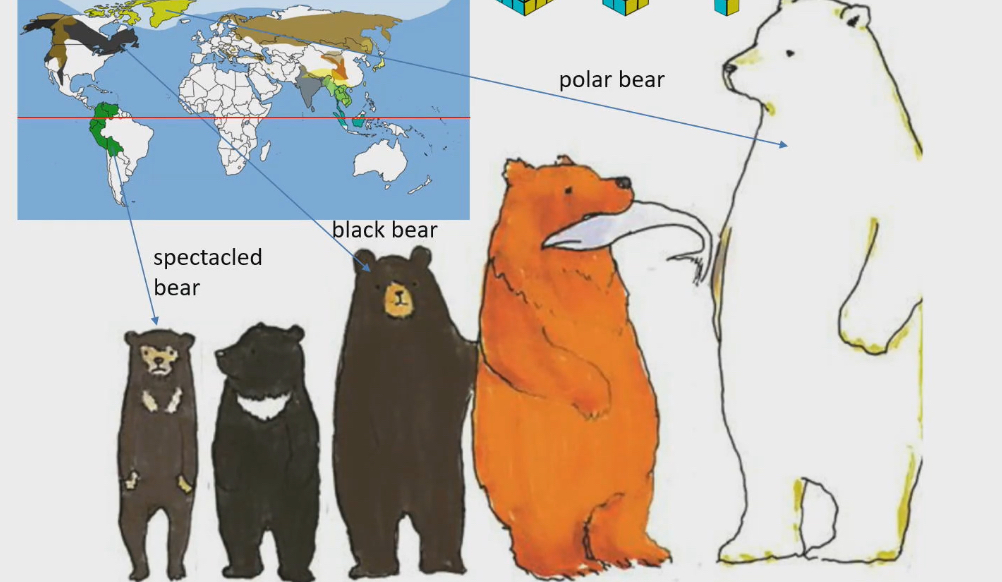
Surface law and Bergman’s rule
Body temp of both spectacled and polar bear is 37ºC
Spectacled bear
body mass 115000g
Stored heat 4255kj
Conductive heat loss 500kj (random #)
Polar bear
body mass 450000g
Stored heat 16650kj
conductive heat =?
Polar bear lost more total heat from body, but smaller proportion to heat that it had
Bigger animal is, slower the rate that body temp will cool
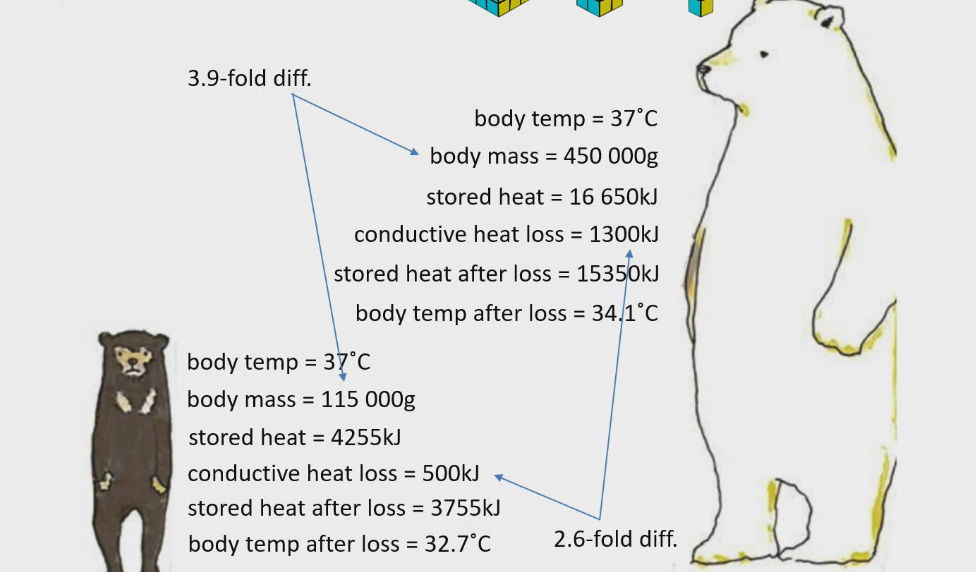
aquatic animals are big
Loosing heat to environment so rapidly because of water environment, big size offsets this loss
Microhabitat selection/behavioural thermoregulation
Animals regulate body temp by moving in environment to find places that are colder or warmer
Not Independent to ectotherms, endotherms do this too because warming through sun is free so you don’t have to use any energy. Unless there is a predator where you want to lay in front of sun, then animal has to access trade off of being warm and being eaten
Only possible if there is thermal heterogeneity (a variability in temp)
lizards do this
At mid morning, they expose themselves to sun
Midday very hot, so they find shade
Late afternoon, they go back to the sun
Is this affective
Iberian wall lizard experiment
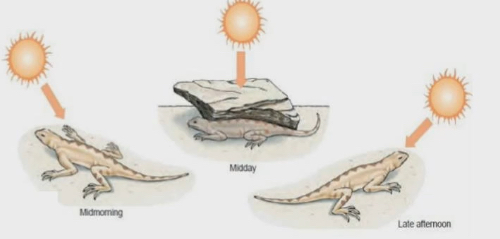
Iberian wall lizard experiment
Put devices in them to monitor body temp and let them back into environment
Body temp variation is 12ºC → thermoregulation mechanism is effective
They put a stuffed lizard environment into the same environment. Body temp went beyond 55ºC = death if it was real
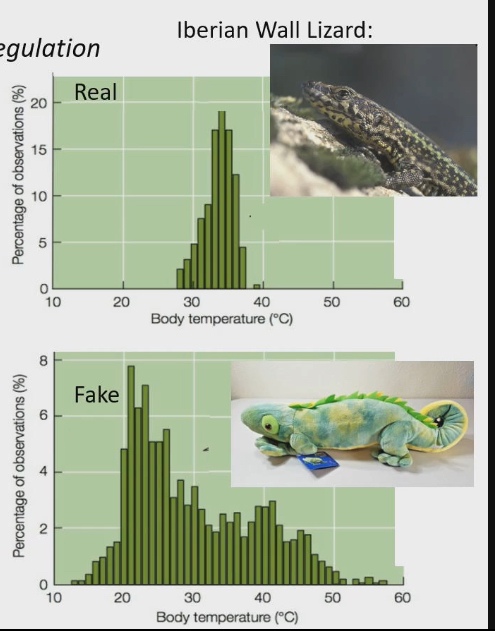
Evaporation
Solid → liquid → gas
Latent heat of fusion : temperature remains constant as solid turns to liquid
Latent hear of vaporization: temperature remains constant as liquid turns to gas
For water its 2260 J/g
Not temp dependant. If body temp is cooler than environment, but you still want to cool down, the only way you could do that is through evaporation
Limitation: humidity
At high humidity evaporation is less able to work